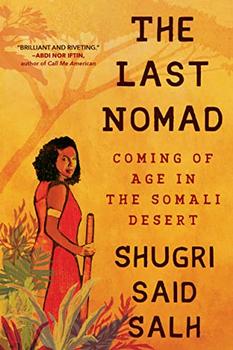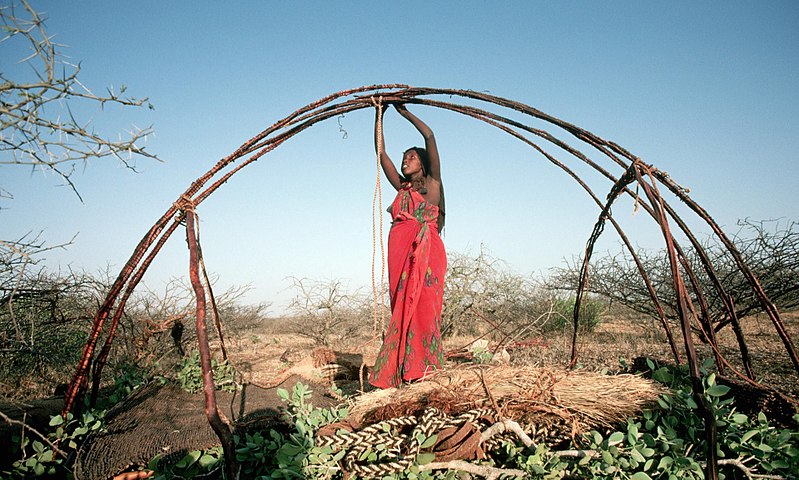Summary | Excerpt | Reading Guide | Discuss | Reviews | Beyond the Book | Read-Alikes | Genres & Themes | Author Bio

Coming of Age in the Somali Desert
by Shugri Said SalhThis article relates to The Last Nomad
 The UN Refugee Agency (UNHCR) estimates that in 2020 there were more than 82 million people displaced from their homes due to human rights issues such as violence and persecution worldwide. And, for as long as humans have existed, people have lived as nomads in various parts of the world, including Somalia, as detailed in Shugri Said Salh's memoir The Last Nomad. There are evident and important differences between cultures with traditions of living in nomadic harmony with the seasons (as in Somalia), people being displaced into forced migration or homelessness, and those who are privileged enough to voluntarily choose to live without a fixed home address. However, any of these situations may involve the use of various types of nomadic housing.
The UN Refugee Agency (UNHCR) estimates that in 2020 there were more than 82 million people displaced from their homes due to human rights issues such as violence and persecution worldwide. And, for as long as humans have existed, people have lived as nomads in various parts of the world, including Somalia, as detailed in Shugri Said Salh's memoir The Last Nomad. There are evident and important differences between cultures with traditions of living in nomadic harmony with the seasons (as in Somalia), people being displaced into forced migration or homelessness, and those who are privileged enough to voluntarily choose to live without a fixed home address. However, any of these situations may involve the use of various types of nomadic housing.
Salh lived with her nomadic grandmother in a shelter called an aqal. This is a tent-like hut built of branches and sticks bound together. The structure is covered with materials such as woven fiber mats, blankets and—in modern times—plastic tarpaulins. An aqal can be disassembled seasonally and bundled for transport on a camel's back, then rebuilt as a temporary homestead. Constructing and maintaining the Somali aqal is a woman's responsibility, and something that she can be judged on by her community and her potential in-laws.
Nomadic Somalis usually travel in family or clan groups, shepherding goats and camels. The United Nations Population Fund (UNFPA) found that, as of 2014, 26% of people in Somalia were living as pastoral nomads. This population has, however, been impacted by civil wars in the region, and has also been constrained by border issues with neighboring Ethiopia and Kenya. Before those national boundaries were set during the colonial era, nomadic people ranged according to clan traditions, weather and seasons without regards to political borders. The pastoral grasslands were managed as common resources, through systems that endured for centuries. The aqal is an ideal shelter for this lifestyle, as it is constructed of locally sourced materials according to designs passed through generations of women, and suited to Somalia's hot, dry climate.
There is a vast tradition of portable housing across cultures, including the Mongolian yurt (ger), the lavvu used by the Sami people of Northern Europe, the indigenous North American tipi, the Inuit iglu, the horse-drawn Romani wagon (vardo) and liveaboard boats. Contemporary portable housing inventions include constructions such as backpacker tents and wheeled mobile homes. Increasingly in urban America, homelessness has resulted in shelters improvised from shopping carts, shipping pallets and cardboard.
While the aqal can be easily transported on camelback, it is not necessarily built to endure disruptions to traditional nomadic life, such as civil war, which has caused many people to flee Somalia. That said, the shelter has survived such disruptions: In 2018, a group of Somali women in Minneapolis built a traditional aqal to serve as a neighborhood gathering place for tea and conversation. Constructed of mostly locally sourced materials, the aqal stood as a reminder that all is not lost no matter the distance traveled, or the wide rifts between friends and family living in diaspora.
Somali woman building an aqal. Photo by Mouseawale88 (CC BY-SA 4.0)
Filed under Places, Cultures & Identities
![]() This "beyond the book article" relates to The Last Nomad. It originally ran in September 2021 and has been updated for the
July 2022 paperback edition.
Go to magazine.
This "beyond the book article" relates to The Last Nomad. It originally ran in September 2021 and has been updated for the
July 2022 paperback edition.
Go to magazine.






Your guide toexceptional books
BookBrowse seeks out and recommends the best in contemporary fiction and nonfiction—books that not only engage and entertain but also deepen our understanding of ourselves and the world around us.